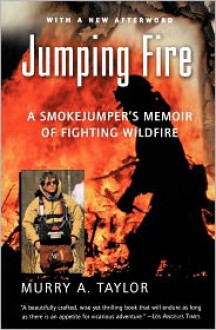
Taylor began smokejumping in 1965 and, near age fifty, finally quit after the summer of 2000, the worst fire season in half a century. Smokejumpers are a bizarre breed who have to pass an extremely rigorous physical fitness test each year — one thing they have to do is run 3 miles in 22 minutes and Marines say smokejumpers training is harder than boot camp — before being allowed back into training. (Interestingly, one of them, Trooper, paid his own way to China in an attempt to convince the Chinese they should begin smokejumping the large fires they have in China, but the Chinese said it was too lethal.)
Jumping into a forest carries its own form of excitement. They carry about 90 pounds of equipment including a 150-foot let-down rope in case they land on the top of a tree — we won't even discuss what happens if they land in a pond or river — and Taylor tells of one jump in some redwood trees where the jumper snagged the top of a redwood, let himself down 150 feet and was still over fifty feet from the ground. His partner had to work the fire line by himself and then saw down a smaller tree against the larger one so he could climb down. Only problem was the concussion of the smaller tree against the larger almost knocked him out of the tree. The jumpers work in tandem with other groups, including spotters in the planes they jump from who help measure wind drift and try to find the best place for them to land — all the jumpers try to sleep on the plane since it may be the last chance they get for several days. And then there are the air tankers, former military C-97s, huge four-engine planes with radial engines, each having sixteen-foot props, fifty-six spark plugs, and fifty-five gallons of oil, that haul sixteen 250-gallon tanks, each of which can be opened individually. The fire retardant used in Alaska is a mixture of water, betonite clay, and ammonium phosphate fertilizer mixed with red dye. It has few adverse effects, but it's best to be clear of the area because three thousand gallons of retardant is "traveling at 130 miles per hour when released. If the load is dropped too low, trees eight to twelve inches in diameter can be ripped out of the ground like matchsticks." Taylor has a degree in forest management. As a high school student, he was a rebel, accumulating a record number of detentions. His tennis coach insisted he attend the prom, and his date with the daughter of the superintendent, a man who was considering whether to suspend or expel him from school, made a huge difference in his life. He managed to get his act together and the girl's family encouraged him to attend college, something he had never even considered a possibility.
The knowledge of forestry is certainly an important element in the training of a smokejumper. Knowing that birch tree resin is much less flammable than that of black spruce and white spruce, and that the birch leaf litter holds water well and quickly decomposes into soil can help determine where to create fire breaks. Night air and birch trees can stop a wall of fire in a matter of minutes. Taylor has seen animals run to small clumps of birch to escape fires and survive unscathed. Of course, sometimes the animals can create problems of their own, and Taylor recounts one episode where they had to watch out for marauding bears foraging through their cache of food and other essential supplies. It was amusing to hear of intrepid men more than willing to take on a forest fire, but completely intimidated by a large brown bear.


 Log in with Facebook
Log in with Facebook 






